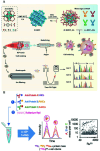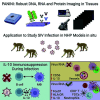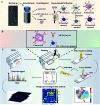Application of metal stable isotopes labeling and elemental mass spectrometry for biomacromolecule profiling
- PMID: 40308936
- PMCID: PMC12035746
- DOI: 10.52601/bpr.2024.240039
Application of metal stable isotopes labeling and elemental mass spectrometry for biomacromolecule profiling
Abstract
Biomacromolecules including proteins and nucleic acids are widely recognized for their pivotal and irreplaceable role in maintaining the normal functions of biological systems. By combining metal stable isotope labeling with elemental mass spectrometry, researchers can quantify the amount and track the spatial distribution of specific biomacromolecules in complex biological systems. In this review, the probes classification and metal stable isotope labeling strategies are initially summarized. Secondly, the technical characteristics and working principle of the elemental mass spectrometry techniques including inductively coupled plasma mass spectrometry and secondary ion mass spectrometry are introduced to achieve highly sensitive detection of multiple biomacromolecules at molecular, cellular and tissue levels. Lastly, we underline the advantages and limitations of elemental mass spectrometry combined with metal stable isotope labeling strategies, and propose the perspectives for future developments.
Keywords: Biomacromolecule; Mass spectrometry analysis; Metal stable isotope labeling.
© The Author(s) 2025.
Conflict of interest statement
Ping Zhang, Ying Han, Yue Xu and Liang Gao declare that they have no conflict of interest.
Figures






Similar articles
-
Metal Stable Isotope Tagging: Renaissance of Radioimmunoassay for Multiplex and Absolute Quantification of Biomolecules.Acc Chem Res. 2016 May 17;49(5):775-83. doi: 10.1021/acs.accounts.5b00509. Epub 2016 Mar 18. Acc Chem Res. 2016. PMID: 26990857
-
Molecules and elements for quantitative bioanalysis: The allure of using electrospray, MALDI, and ICP mass spectrometry side-by-side.Mass Spectrom Rev. 2019 Mar;38(2):169-186. doi: 10.1002/mas.21567. Epub 2018 Mar 30. Mass Spectrom Rev. 2019. PMID: 29603315 Review.
-
Metal-tag labeling coupled with multiple reaction monitoring-mass spectrometry for absolute quantitation of proteins.Analyst. 2013 Sep 21;138(18):5309-17. doi: 10.1039/c3an00613a. Epub 2013 Jul 18. Analyst. 2013. PMID: 23869378
-
The synergy of elemental and biomolecular mass spectrometry: new analytical strategies in life sciences.Chem Soc Rev. 2009 Jul;38(7):1969-83. doi: 10.1039/b618635c. Epub 2009 Apr 16. Chem Soc Rev. 2009. PMID: 19551177 Review.
-
Detection of counterfeit antiviral drug Heptodin and classification of counterfeits using isotope amount ratio measurements by multicollector inductively coupled plasma mass spectrometry (MC-ICPMS) and isotope ratio mass spectrometry (IRMS).Sci Justice. 2009 Jun;49(2):102-6. doi: 10.1016/j.scijus.2008.12.003. Sci Justice. 2009. PMID: 19606588
References
LinkOut - more resources
Full Text Sources
